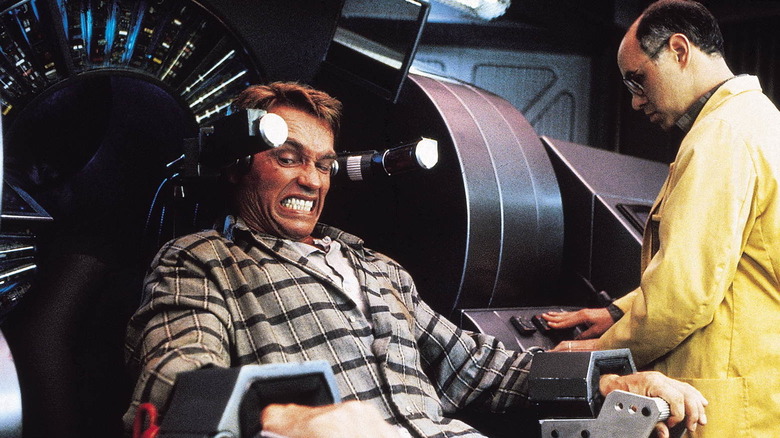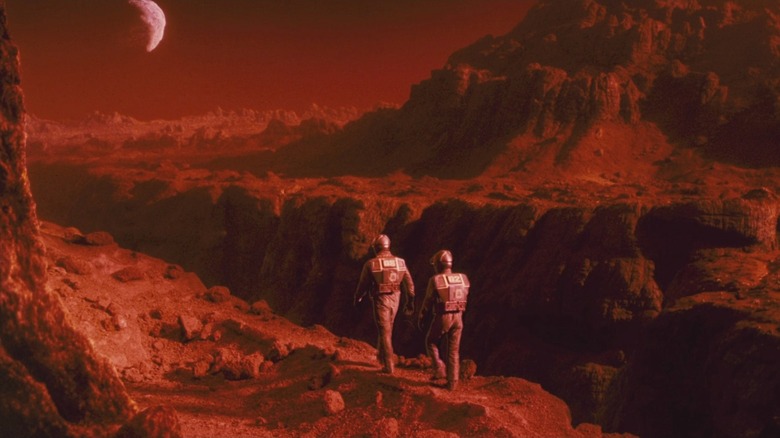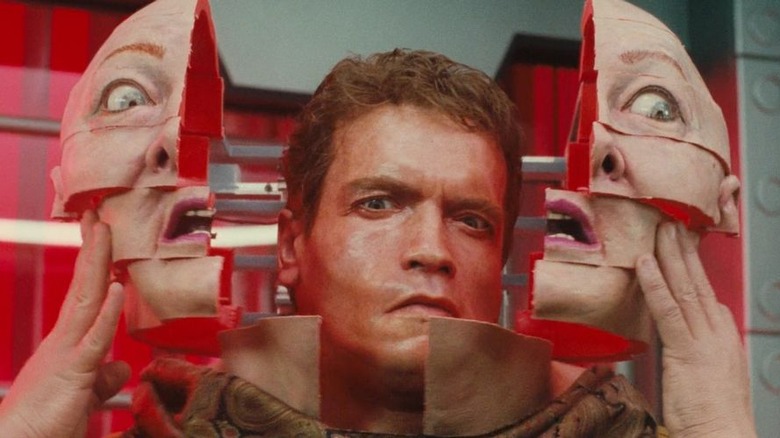How The Total Recall Crew Built Mars On Earth
Martin Scorsese once said, "Movies touch our hearts and awaken our vision, and change the way we see things. They take us to other places, they open doors and minds." Where Scorsese and other great filmmakers succeed is in knowing how to take us to other places. But what about places that don't even exist on Earth?
In Paul Verhoeven's 1990 classic "Total Recall," Douglas Quaid (Arnold Schwarzenegger) questioned what was real and what was fake after a memory is implanted in his head. Based on Philip K. Dick's short story "We Can Remember It for You Wholesale," much of the film takes place on Mars.
With a talented design team and a budget that Forbes reports as one of the largest in cinema history at the time, "Total Recall" left audiences asking the same thing: what is real and what is fake? How did Verhoeven bring Mars to life without leaving the planet? Ironically, the sci-fi production team looked to the past while becoming a gold standard for a dying art form in Hollywood.
Taking Over Mexico City
According to BFI, the film was shot in Mexico City's Estudios Churubusco, one of Latin America's oldest film studios. Despite the film's bloated budget, Mel Johnson Jr., who plays Benny, told Syfy Wire that the film actually felt like a low-budget production because every dime went towards the production of the film. Trailers, catering, and amenities were kept to a minimum to maximize the budget for the six-month shoot.
A big portion of the expenses was taking over part of Mexico City, building roads and tunnels to connect the various filming locations. Filming in Mexico also allowed the production team certain liberties. As Johnson explained, "...they were using like naphthalene, which is one step below napalm, for those explosions in that first scene there.
Michael Ironside, who plays the film's antagonist Richter, told BFI:
"When we were shooting, we'd start off in the one city on Mars and start firing at each other and head into the tunnels, and come out into the other city where the cast and crews were all in place. At any given time, you'd have close to three to four hundred extras working, some of them in full prosthetic makeup."
"Total Recall" was made as two filmmaking techniques were passing in the night. The use of miniatures and practical effects had been mastered, while computer generated imagery (CGI) was in its infancy. Visual effects supervisor Eric Breving explained that the effects team opted for the proven methods, telling FXGuide, "All of our imagery, like the Mars exteriors, was organic. There was a spaceship shot and I guess that could have been attempted, but using miniatures and motion control technology was such a mature technology at that time."
The Last Time Everything Was Real
What makes "Total Recall" even more impressive is that all but one shot was done with practical effects (the X-ray scanner scene was CGI). Creating Mars is one thing, but how about an entire city of mutants? For that, Verhoeven turned to legendary makeup artist Rob Bottin, who was a staple of 1980s cinema. Bottin's resume includes "The Thing," "Innerspace," and "Robocop." For his work on "Total Recall," Bottin would win a Special Achievement Academy Award.
In reminiscing about the film's construction, Johnson said, "It was a huge production; they were using real explosions, this was the last time everything was real, no CGI, so all those explosions were real, they were greasing up people, I was freaking out." The following year, "Terminator 2" (coincidentally, also starring Arnold Schwarzenegger) would rake in $204 million at the box office, ushering in a new CGI era in Hollywood.
Like gunfighters making their last stand, Verhoeven and Bottin turned to a dusty old studio in Mexico to create one of the last vestiges of sci-fi masterpieces using only practical effects. There's nothing computer-generated about why "Total Recall" remains firmly implanted in the hearts and minds of sci-fi fans.


